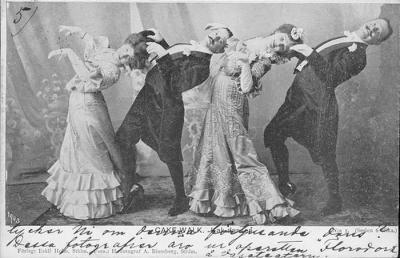Cakewalk
 The Cake Walk (or Cakewalk) was the first of the new dances for the new Century, emerging into mainstream white popular culture somewhere after 1890 and remaining popular until the early 20th Century. It originated with African Americans lampooning the affected manners of the White Folk, but the White Folk either didn't get the joke or agreed that the manners of the White Folk needed a little satire, and joined in the fun.
The Cake Walk (or Cakewalk) was the first of the new dances for the new Century, emerging into mainstream white popular culture somewhere after 1890 and remaining popular until the early 20th Century. It originated with African Americans lampooning the affected manners of the White Folk, but the White Folk either didn't get the joke or agreed that the manners of the White Folk needed a little satire, and joined in the fun.
It had been a mainstay of Minstrel, Vaudeville and Music Hall performers for years before it became a popular dance and they used it as a medium for all manner of comic and eccentric dancing. Once it became a mainstream dance that everyone was doing, it created something of a dialogue, with performers mimicking and then adding to what the public was doing with the public then being inspired to even more eccentric feats by what they saw on stage.
It was a group dance, led by a couple or an individual and followed by a column of couples, who mimicked or complemented the actions of the lead couple. It could also pause, while a single individual or couple did a routine while everyone else watched while keeping time.
 The dancers frequently equipped themselves with top hats and canes for the gents and parasols for the ladies - though this was not in any way a requirement. The actions were frequently quite energetic, and often decidedly silly, and there were a variety of practiced and improvised steps. The singing frog from the famous Warner Brothers cartoon is doing a Cake Walk kick step as he sings "Hello ma baby.."
The dancers frequently equipped themselves with top hats and canes for the gents and parasols for the ladies - though this was not in any way a requirement. The actions were frequently quite energetic, and often decidedly silly, and there were a variety of practiced and improvised steps. The singing frog from the famous Warner Brothers cartoon is doing a Cake Walk kick step as he sings "Hello ma baby.."
I think the great appeal of the Cake Walk to late Victorian society was its silliness. Its utter lack of dignity and decorum was a great release and a way for the younger folks of the time to embrace the freedom of the new Century and reject the stuffiness and stilted manners of their 19th Century upbringing. It was a socially sanctioned form of otherwise totally unacceptable behavior. The social license that came with the Cake Walk spread to dancing in general and made possible the utter goofiness of the later One-Step variations like the Grizzly Bear (dancers lumber like bears, give each other bear hugs, chase each other, rub their backs on each other like a bear against a tree etc.)
It was all a bit mad and chaotic as you will see from the following videos. These dancers are, of course, professionals who were doing much fancier stuff than most ordinary folks could muster, but if you can manage anything vaguely similar, you'll be fine. Cake Walk is, more than anything else, a state of mind.
